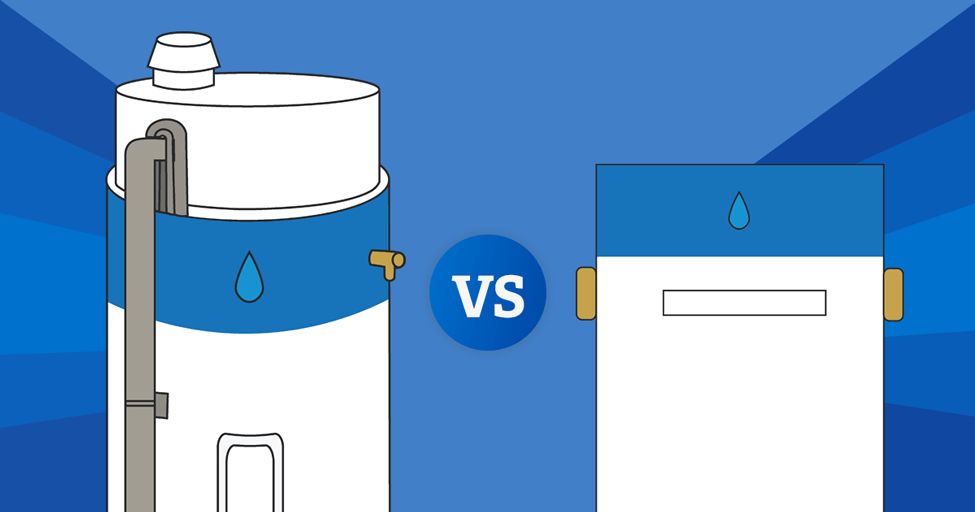When it comes to on-demand hot water, homeowners have two main options – instant (also called point-of-use) water heaters and tankless water heaters. Both provide hot water as needed without the need for a storage tank, but there are some key differences between the two.
Page Contents
How Do Instant Water Heaters Work?
Instant or point-of-use electric water heaters work by heating water directly as it flows through the unit. They are small, under-sink units that heat a small amount of water at a time as it passes over heating coils or elements. When the hot water tap is turned on, cold water travels through the coils and is heated immediately. Once the tap is turned off, heating stops.
Advantages of instant water heaters:
- Compact size is ideal for heating water at a single sink or application
- Lower upfront costs compared to whole-home systems
- Provides hot water on demand without a tank
- Simple to install under sink
- Energy efficient since no water is stored hot when not in use
Disadvantages:
- Limited flow rate – usually 2-5 gallons per minute
- Not suitable for uses requiring high water flow like showering
- Only provides hot water at installation point
How Do Tankless Water Heaters Operate?
Tankless water heaters, also known as on-demand or continuous flow water heaters, work differently than conventional storage tank heaters. Instead of constantly heating and re-heating water in a storage tank, tankless systems only heat water as it flows through the unit. Cold water travels through a network of piping and passes across heating coils or burners. The water is heated instantly, providing a consistent hot water supply.
Benefits of tankless water heating:
- Endless on-demand hot water
- Space saving without large tank
- Energy efficiency since water isn’t stored and reheated
- Long lasting – heat exchangers have lifespan of 20+ years
- Lower operating costs compared to tank
Downsides of tankless heaters:
- Higher upfront costs
- May need electrical service upgrades
- Flow limitations for very large homes
- Not effective for homes with low water pressure
Key Differences
While instant and tankless water heaters both provide hot water on demand without a tank, there are some important differences:
| Factor | Instant Water Heater | Tankless Water Heater |
|---|---|---|
| Function | Heats small amount of water at a time for single use | Heats water for whole home use |
| Size | Compact under sink unit | Larger whole home unit |
| Flow Rate | 2-5 gallons per minute | Typically 3-5 gallons per minute* |
| Applications | Single sink or point-of-use | Whole home |
| Cost | Less expensive | More expensive |
| Installation | Easy under-sink | Professional recommended |
*Tankless flow rate depends on unit size – small units may be as low as 2 GPM while larger models can supply over 10 GPM.
Sizing Considerations
One of the key sizing considerations with tankless water heaters is the maximum flow rate. Tankless heaters are rated by the maximum temperature rise they can provide at a given flow rate. For example, a unit may be able to heat 3 GPM from 50°F to 105°F. Larger homes with higher demand may require multiple tankless units or high flow models.
Flow rate is not an issue when sizing instant water heaters because they are only heating water for a single application. Even a small 2-3 GPM unit is sufficient for a kitchen sink or bathroom lavatory.
Installation Requirements
Installation is simple for instant water heaters – just mount the compact unit under the sink and connect hot/cold water supply and drain lines. Electrical connections are also straightforward.
In comparison, tankless water heater installation is more complex. Units require proper venting to the outdoors, condensate drains, gas and water lines, electrical connections, and mounting. Outdoor units also need weatherproof enclosures. Venting requirements depend on the fuel type. Having a professional install tankless water heaters is highly recommended.
Operating Costs
Tankless water heaters have lower operating costs compared to conventional tank heaters because they only heat water as needed and don’t have standby losses from stored hot water. Energy savings may be as much as 20-30%.
The operating costs of instant water heaters are low since they are only in use for short durations as needed at the point of use. They do not produce standby losses, unlike storage tank heaters.
Choosing Between Instant and Tankless
When deciding between instant and tankless water heaters, here are some factors to consider:
- Application – Instant for single point-of-use, tankless for whole home
- Flow rate needed – Instant provides 2-5 GPM, tankless up to 10+ GPM
- Installation requirements – Instant is easy DIY, tankless often requires pro
- Upfront costs – Instant units less expensive, tankless more pricey
- Operating costs – Both options are energy efficient
In summary:
- Instant water heaters are best for point-of-use applications like a kitchen sink or bathroom vanity
- Tankless water heaters work well for whole home hot water needs
- Those with higher hot water demands or flow rates should choose tankless
Conclusion
Instant and tankless water heaters both provide hot water on demand without the limitations and energy losses of tank style heaters. While they are both great options for energy efficient hot water, instant units are best suited to low flow point-of-use applications. For whole home hot water needs, tankless heaters are the better choice especially for larger homes with higher demand.
Tankless water heaters require professional installation and have higher upfront costs, but pay back through energy savings over time. Instant heaters are inexpensive and simple to install as under sink units, but can only supply hot water to limited applications. Understanding the differences in how they work and factors like size, flow rates, and installation will help homeowners choose the best on-demand water heating solution.
